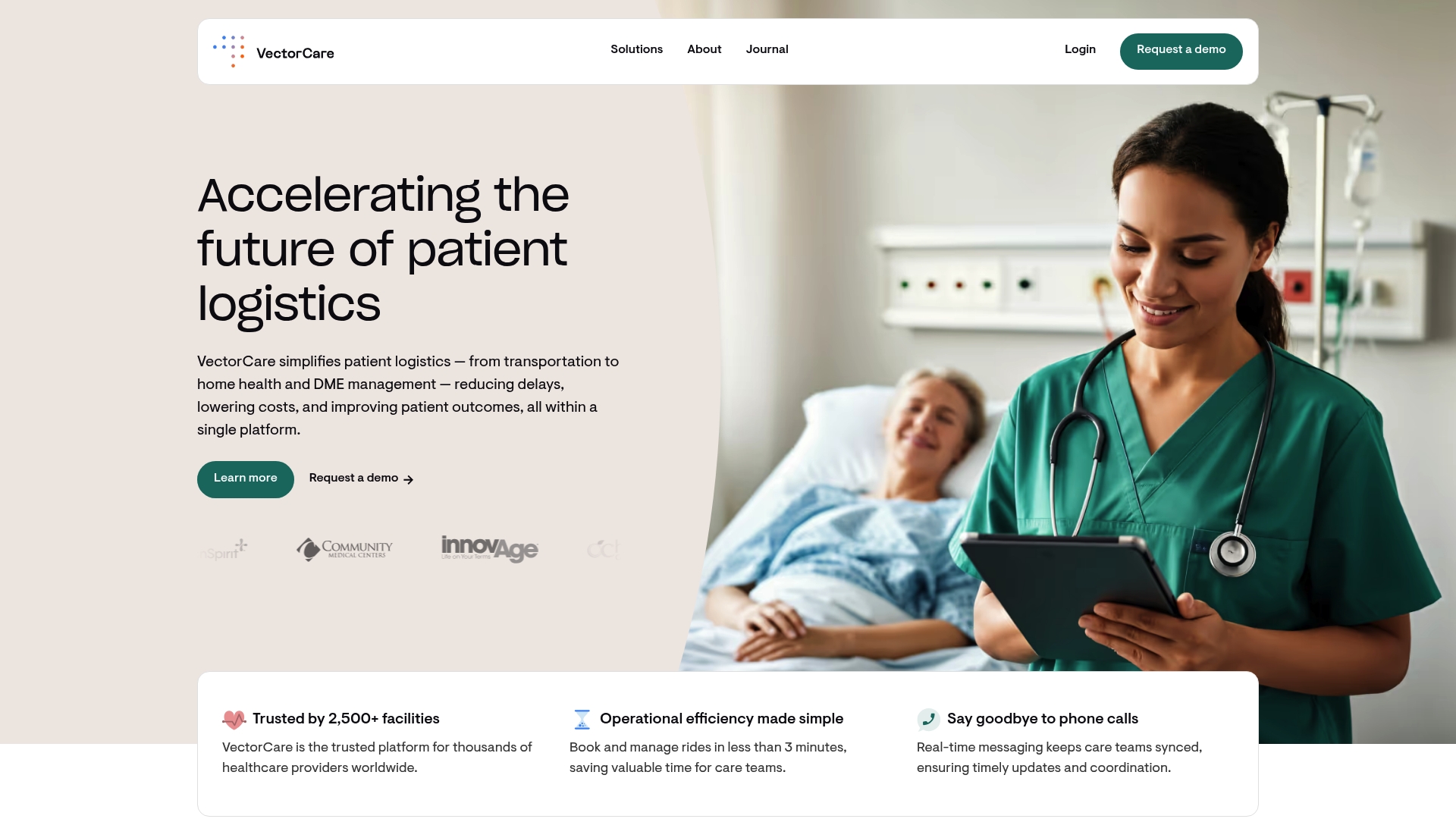7 Essential Tips for Online Scheduling in Healthcare

Did you know that clinics using online scheduling see up to a 40 percent drop in no-show rates? Streamlining appointment management is changing the way patients access care and how providers run their daily operations. Whether you manage a small clinic or a large hospital, digital scheduling tools can help you reach more patients and reduce the paperwork that bogs down your staff, creating a win-win environment for everyone involved.
Table of Contents
- Understand The Core Benefits Of Online Scheduling
- Choose Platforms With Robust Security Features
- Automate Recurring And Routine Appointments
- Leverage Real-Time Updates For Better Communication
- Integrate Scheduling With Logistics And Dispatch Systems
- Use Data Insights To Optimize Scheduling Workflows
- Train Staff For Seamless Technology Adoption
Quick Summary
| Takeaway | Explanation |
|---|---|
| 1. Embrace Online Scheduling Benefits | Online scheduling improves patient experiences with 24/7 access and reduces administrative workloads. |
| 2. Ensure Strong Security Features | Choose platforms with robust security protocols to protect patient data, maintaining trust and confidentiality. |
| 3. Automate Routine Appointments | Implement automated systems for recurring appointments to enhance efficiency and focus on patient care. |
| 4. Utilize Real-Time Communication | Real-time updates foster transparency and reduce patient anxiety by providing immediate scheduling information. |
| 5. Analyze Scheduling Data for Insights | Leverage data analytics to optimize workflows, predict patient volume, and improve resource allocation for better service. |
1. Understand the Core Benefits of Online Scheduling
Online scheduling represents a transformative approach to healthcare appointment management that goes far beyond simple digital convenience. By leveraging technology, healthcare providers can dramatically improve patient experiences and operational efficiency.
At its core, online scheduling delivers 24/7 appointment accessibility that fundamentally changes how patients interact with healthcare services. Unlike traditional phone based booking systems, patients can schedule appointments anytime and anywhere using their preferred digital devices. According to research from Understanding Patient Scheduling Best Practices for Providers, this flexibility significantly enhances patient satisfaction and engagement.
The administrative benefits are equally compelling. Online scheduling systems automatically reduce call volumes and administrative workloads by enabling patients to independently manage their appointments. Healthcare staff can redirect their energy from repetitive scheduling tasks to more meaningful patient care activities. Automated features like appointment confirmations and reminders further streamline operations and minimize costly no show rates.
Key benefits healthcare providers can expect include:
- Reduced Administrative Burden: Automated scheduling reduces manual data entry and phone coordination
- Enhanced Patient Accessibility: 24/7 booking options accommodate diverse patient schedules
- Improved Communication: Instant confirmations and automated reminders decrease missed appointments
- Operational Efficiency: Simplified scheduling process allows staff to focus on patient care
By embracing online scheduling, healthcare organizations can create a more patient centered experience while simultaneously optimizing internal workflows. The technology transforms scheduling from a transactional process into a strategic patient engagement tool.
2. Choose Platforms with Robust Security Features
In the digital healthcare landscape, patient data protection is not just a preference. It is an absolute necessity. Online scheduling platforms must serve as fortresses of confidentiality, ensuring every patient interaction remains secure and protected.
Patient data security transcends basic compliance. It represents a fundamental commitment to maintaining patient trust and protecting sensitive medical information. According to research from 4 Ways Technology is Enhancing Patient Appointment Logistics Across Healthcare, secure communication channels between patients and healthcare providers are critical in modern medical technology.
When evaluating online scheduling platforms, healthcare providers should prioritize comprehensive security measures. This means looking beyond surface level protections and examining robust encryption protocols, secure data transmission methods, and comprehensive access controls.
Key security features to assess include:
- HIPAA Compliance: Platforms must meet strict healthcare privacy regulations
- End to End Encryption: Protect data during transmission and storage
- Multi Factor Authentication: Prevent unauthorized system access
- Regular Security Audits: Continuously validate and update security protocols
Beyond technical specifications, security represents a holistic approach to patient care. By selecting platforms with advanced security frameworks, healthcare providers demonstrate their commitment to patient privacy and build foundational patient trust. The right scheduling platform does more than book appointments. It protects patient dignity and confidential medical information.
3. Automate Recurring and Routine Appointments
Healthcare scheduling is evolving from manual management to intelligent automation. Recurring appointments represent a critical opportunity to streamline patient care and reduce administrative overhead.
Automated scheduling transforms routine medical interactions by eliminating repetitive manual tasks. Systematic appointment management allows healthcare providers to focus on patient care instead of administrative logistics. As indicated in Optimize Patient Care with a Home Health Scheduling App, technology now enables seamless scheduling for consistent patient treatments.
By implementing smart scheduling systems, providers can create predefined appointment templates for patients requiring regular medical attention. Chronic disease management, physical therapy, mental health counseling, and routine wellness checks become substantially more efficient when automated scheduling takes center stage.
Key strategies for effective recurring appointment automation include:
- Customizable Scheduling Templates: Create flexible recurring appointment configurations
- Patient Preference Tracking: Remember individual patient scheduling preferences
- Automatic Reminder Systems: Send timely notifications for upcoming routine appointments
- Integration with Electronic Health Records: Ensure seamless patient information management
Successful automation requires understanding each patient’s unique care requirements. The goal is not just efficiency but creating a personalized healthcare experience that feels responsive and attentive. By leveraging intelligent scheduling technologies, healthcare providers can dramatically improve patient engagement and operational effectiveness.
4. Leverage Real-Time Updates for Better Communication
Effective healthcare communication is no longer about static information. Real-time updates transform patient interactions from passive experiences to dynamic engagements that prioritize transparency and immediate information sharing.
Digital communication channels represent a revolutionary approach to patient scheduling and management. According to How Effective Round-Trip Ride Scheduling Enhances Patient Care, modern healthcare technologies enable instantaneous information exchange that dramatically improves patient experiences.
Real-time updates provide patients with immediate confirmation, changes, and critical appointment details. Instead of waiting on hold or playing phone tag, patients receive instant notifications about scheduling modifications, wait times, and appointment statuses directly on their preferred devices. This approach reduces patient anxiety and demonstrates a commitment to transparent healthcare communication.
Key features of effective real-time communication include:
- Instant Appointment Confirmations: Immediate verification after booking
- Automated Reminder Systems: Timely notifications about upcoming appointments
- Status Change Alerts: Quick updates regarding scheduling modifications
- Two Way Communication Channels: Enable patients to respond or reschedule easily
Healthcare providers who embrace real-time communication technologies demonstrate a patient centered approach. By providing immediate, accessible information, they build trust and reduce the uncertainty often associated with medical appointments. The goal is not just to schedule but to create a seamless, supportive patient experience that feels responsive and personalized.
5. Integrate Scheduling with Logistics and Dispatch Systems
Healthcare logistics represent a complex ecosystem where seamless communication between scheduling and transportation systems can dramatically transform patient care delivery. Integrating scheduling platforms with dispatch systems creates a synchronized approach that elevates operational efficiency.
Comprehensive care coordination goes beyond simple appointment booking. According to Hospital Patient Logistics Platform, effective integration allows healthcare providers to create end to end patient transportation experiences that reduce wait times and improve overall service quality.
The magic happens when scheduling systems communicate directly with transportation and logistics networks. This means automatic route optimization, real time vehicle tracking, and instantaneous updates about patient transportation status. By eliminating manual coordination steps, healthcare organizations can reduce administrative overhead and create more predictable patient experiences.
Key strategies for successful system integration include:
- Unified Data Platforms: Ensure scheduling and dispatch systems share consistent patient information
- Automated Routing Algorithms: Optimize transportation based on patient needs and geographical factors
- Real Time Tracking Capabilities: Monitor transportation status and provide accurate estimated arrival times
- Comprehensive Communication Channels: Enable seamless updates between patients, providers, and transportation teams
Successful integration transforms logistics from a logistical challenge into a strategic patient care opportunity. Healthcare providers who embrace these technologies demonstrate a commitment to patient centered care that prioritizes convenience, efficiency, and comprehensive support.
6. Use Data Insights to Optimize Scheduling Workflows
Data has become the strategic compass guiding modern healthcare operations. Online scheduling systems are no longer passive tools but powerful analytics platforms that transform raw information into actionable organizational intelligence.
Predictive scheduling analytics enable healthcare providers to move beyond reactive management. According to Healthcare Data Insights for Providers and Agencies 2025, advanced data analysis can reveal nuanced patterns in patient behavior and operational efficiency that were previously invisible.
By systematically analyzing scheduling data, healthcare organizations can uncover critical insights about patient preferences, peak appointment times, no show rates, and resource utilization. These insights allow practices to design more intelligent scheduling strategies that maximize provider productivity and patient satisfaction.
Key strategies for leveraging scheduling data include:
- Demand Forecasting: Predict patient volume and adjust staffing accordingly
- Peak Time Analysis: Identify optimal scheduling windows for different services
- No Show Pattern Recognition: Develop targeted strategies to reduce missed appointments
- Resource Allocation Optimization: Align provider schedules with actual patient needs
Successful data driven scheduling transforms administrative processes from guesswork into precision. Healthcare providers who embrace these analytical approaches demonstrate a commitment to continuous improvement and patient centered care.
7. Train Staff for Seamless Technology Adoption
Technology adoption in healthcare is not about purchasing new systems. It is about empowering your team to embrace and effectively utilize innovative tools that transform patient care delivery.
Comprehensive staff training creates the foundation for successful technological integration. According to Healthcare Workforce Optimization Strategies for 2025 Success, organizations that invest in strategic technology training see significantly higher rates of successful system implementation and staff satisfaction.
Effective training goes beyond basic software instructions. It requires creating a culture of technological curiosity where staff understand not just how to use new systems but why these tools matter. This approach transforms technology from a potential source of frustration into a powerful ally in delivering exceptional patient experiences.
Key strategies for successful technology training include:
- Phased Learning Approach: Implement gradual training modules that build confidence
- Hands On Practice Sessions: Create realistic scenario based learning environments
- Peer Support Networks: Develop internal champions who can provide ongoing guidance
- Continuous Learning Opportunities: Offer regular refresher courses and update training
Successful staff training turns technological adoption from a challenge into an organizational strength. Healthcare providers who prioritize comprehensive education demonstrate a commitment to both technological innovation and their team’s professional growth.
Below is a comprehensive table summarizing the main strategies and benefits of online scheduling in healthcare as discussed throughout the article.
| Strategy/Aspect | Key Actions & Features | Benefits/Outcomes |
|---|---|---|
| Online Scheduling Benefits | 24/7 appointment access; automated confirmations and reminders | Enhanced patient satisfaction; reduced no-show rates; staff focus on patient care |
| Security Features | HIPAA compliance; end-to-end encryption; multi-factor authentication | Maintains patient trust; protects sensitive data; ensures confidentiality |
| Automate Recurring Appointments | Use scheduling templates; integration with health records; automatic reminders | Streamlines patient care; reduces administrative work; better patient engagement |
| Real-Time Updates | Instant confirmations; status change alerts; two-way communication | Reduces patient anxiety; improves transparency; enhances communication |
| Integration with Logistics | Unified data platforms; automated routing; real-time tracking | Reduces wait times; enhances service quality; comprehensive patient experience |
| Data Insights for Optimization | Demand forecasting; peak time analysis; no-show pattern recognition | Maximizes productivity; improves scheduling strategies; aligns resources with needs |
| Staff Training | Phased learning; hands-on practice; peer support networks | Successful technology adoption; improves staff satisfaction; strengthens organizational capabilities |
Transform Your Healthcare Scheduling with VectorCare Solutions
The challenge of managing recurring appointments, ensuring data security, and integrating real-time communication often creates friction between providing top-quality care and handling administrative tasks. This article highlights essential strategies like automating routine visits and leveraging real-time updates that resonate deeply with healthcare providers seeking to reduce operational burdens while enhancing patient experiences. If you are striving to deliver seamless, secure, and efficient scheduling workflows that align perfectly with patient needs, VectorCare offers a comprehensive platform purpose-built for these exact challenges.
Experience the power of automation, real-time updates, and AI-driven dispatching to simplify scheduling and logistics. Our platform supports secure communication channels, customizable appointment management, and integration with transportation systems to streamline your operations and improve patient satisfaction.

Ready to elevate your healthcare scheduling and patient logistics? Visit VectorCare now to discover how our solutions help reduce administrative workload, cut costs, and improve outcomes. Take the next step toward cutting-edge scheduling optimization and data-driven care coordination by exploring our platform today.
Frequently Asked Questions
What are the core benefits of online scheduling in healthcare?
Online scheduling provides 24/7 appointment accessibility, reducing administrative workloads, and improving patient communication. To maximize these benefits, implement an online scheduling system that allows patients to book appointments anytime, streamlining your operational processes.
How can I ensure my online scheduling platform is secure?
To protect patient data, look for online scheduling platforms that are HIPAA compliant and utilize end-to-end encryption. Assess your chosen platform’s security measures thoroughly, conducting regular reviews to ensure patient information remains confidential.
What features should I look for in an online scheduling system for recurring appointments?
An effective online scheduling system should include customizable templates, automatic reminders, and integration with patient records. Set up these features to minimize manual tasks and enhance the efficiency of managing routine appointments.
How do real-time updates improve communication with patients?
Real-time updates provide instant notifications about appointment statuses and changes, enhancing transparency in patient interactions. Enable these features to reduce patient anxiety and foster a more dynamic healthcare experience.
What steps can I take to integrate scheduling with transportation logistics?
To successfully integrate scheduling with logistics, ensure your systems share patient data consistently and can optimize transportation routes. Start automating these processes to create a seamless experience for patients, reducing wait times and improving care coordination.
How can I train my staff effectively for new online scheduling technology?
Implement a phased training approach that includes hands-on practice and ongoing support from internal champions. Focus on creating an environment that encourages questions and enthusiasm about the technology, leading to higher staff confidence and smoother adoption.



